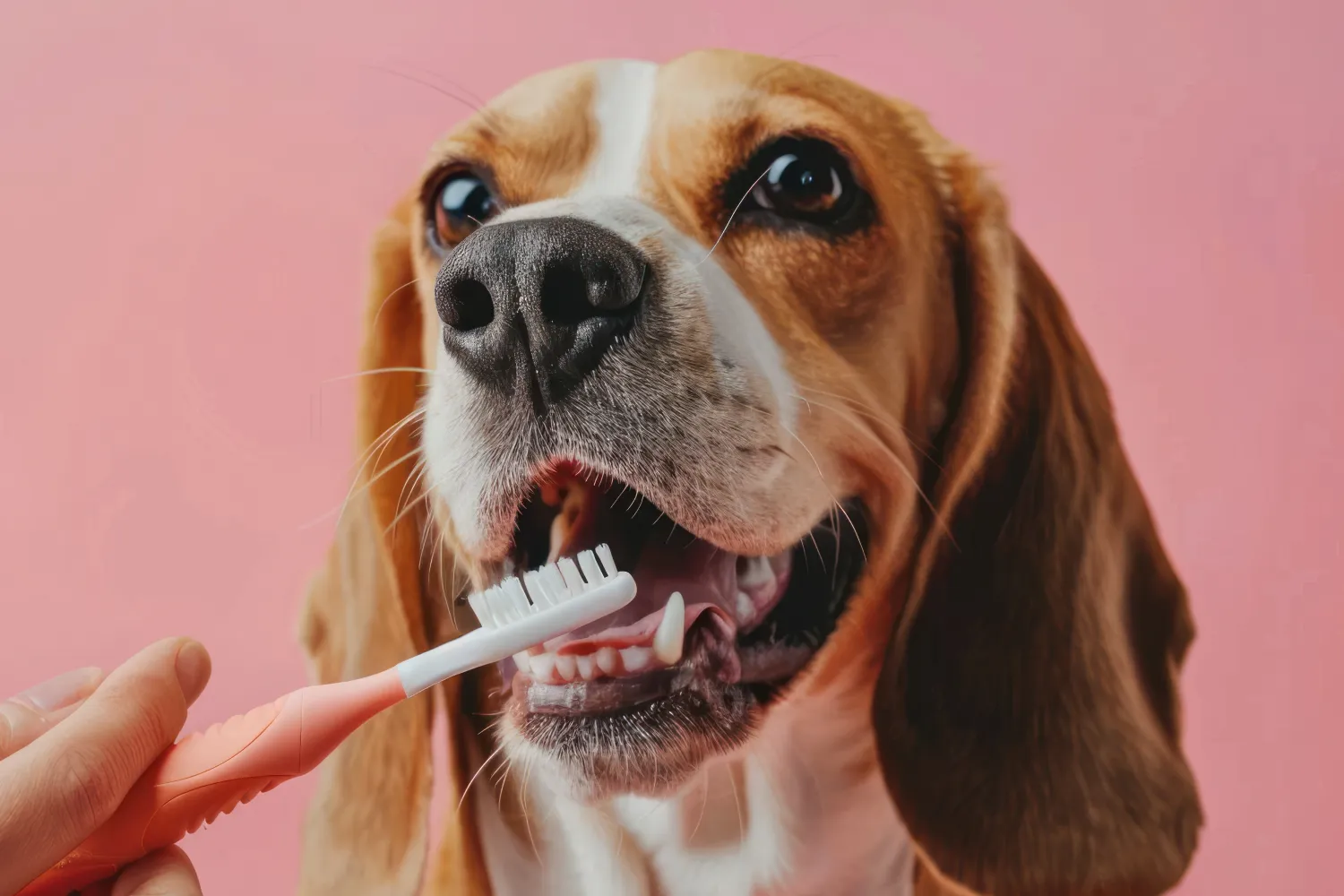
BOGO: buy a box of Longevity15 and get Yummy Combs free!
Shop now and get the BOGO deal today!
Joseph Roetheli, PhD

Highlights:
Gum disease is common in dogs, affecting 80% of dogs over age three.
Left untreated, gum disease can lead to significant health problems, including organ failure.
Giving your dog a tartar-removing dental chew like Yummy Combs® can help manage the risk of your dog developing gum disease.
You love everything about your dog, from their wagging tail to their unique personality. You wouldn’t change a thing about your dog, except maybe their breath. Let’s
face it; dog breath stinks, but it doesn’t have to. In fact, it really shouldn’t.
Foul breath in dogs can be indicative of dental issues like cavities, tartar buildup, and dental disease. These issues can lead to more serious problems with your dog’s health, like loss of teeth, periodontal disease (gum disease), and even organ failure.
The good news is that taking proper care of your dog’s teeth can help prevent gum disease in your dog and give them the chance to live a longer, healthier, pain-free life. We’ll explain what’s going on inside your dog’s mouth, what risks are associated with a lack of oral care, and what you can do at home to keep your dog’s mouth clean, safe, and odor-free.
If you’ve had your dog since they were a puppy, you likely remember the phenomenon of “puppy breath.” Puppy breath, or the breath a dog has for a few months of their early lives, happens for several reasons,
including access to their mother’s milk and digestive enzymes in their stomachs, but puppy breath also reflects a mouth with very clean teeth.
Keeping those teeth clean can be a challenge, especially once your dog loses their puppy teeth and reaches adulthood. Unlike humans, dogs don’t make brushing and flossing a regular habit, so oral hygiene declines almost immediately.
Your dog’s teeth need regular maintenance and care, just like your own teeth. Unfortunately, loading up a toothbrush with dog-approved toothpaste and brushing your dog’s teeth isn’t as easy as brushing your own.
Most dog owners simply avoid dental care or opt for a once-a-year cleaning at the veterinarian’s office performed under some type of local anesthetic or general anesthesia. The risks to your dog’s oral health when oral care is avoided are significant.
Gum disease, for instance, an advanced state of dental disease, is directly linked to organ failure in dogs.
Before advanced stages of dental issues occur (like gum disease), there are signs your dog’s oral health may be compromised.
These are the earliest signs your dog could be at risk of developing gum disease. If your dog’s dental issues are not addressed, they can experience organ failure down the road.
These symptoms may include:
At this point, your dog’s dental care must be addressed to prevent further damage to their teeth and overall health.
Although nearly 80% of dogs over the age of three years have periodontal disease, their owners rarely know it.
Advanced stages of gum disease can lead to:
Bacteria enter your dog’s body through the mouth, and without routine check-ups, dental cleanings, and daily care, that bacteria can take up residence in your dog’s mouth and eventually enter the bloodstream, causing infection throughout the body and shortening your dog’s lifespan.
A major problem with gum disease in dogs is detection. Most of the time, gum disease is not recognized until it progresses into later stages.
Your pet’s yearly check-up involves a visual examination of your dog’s teeth, but a complete oral exam with dental X-rays is often needed to determine the actual condition of your dog’s dental health.
As serious as gum disease is, we want to do everything we can to prevent it. If we can eliminate periodontal disease, we can add years to our dog’s health span.
To keep your dog’s teeth healthy, you’ll need to be proactive with their dental care at home, ensure they receive professional cleansings periodically, and help your dog stay comfortable during the process.
Your dog should have an annual dental screening and cleaning at least once per year, beginning as early as six months for small breeds and one year of age for larger breeds. Small breeds are more susceptible to gum disease.
During this routine dental procedure, your veterinarian will examine your dog’s teeth, clean them, and possibly run blood work to ensure your dog doesn’t have an infection. Most of the time, your dog will be placed under anesthesia to ensure your veterinarian can access their mouths safely and easily and to ensure your dog is comfortable.
Practicing good dental care with your dog may take a little patience, but the benefits of keeping them healthy and increasing their longevity are rewards both you and your dog deserve — and can experience! Developing a daily dental care routine can be an enjoyable bonding time with your dog. With a little practice, you’ll both become fast experts and will bond along the way.
Brushing your dog’s teeth is the best way to prevent gum disease and keep your dog’s teeth clean. To begin, approach your dog when they are relaxed and calm.
Oral care is likely new to your animal, so remember that they may be scared when you begin attempting to place a toothbrush in their mouth! Always use a soft-bristled toothbrush and dog-safe toothpaste, and aim to brush once per day.
The Veterinary Oral Health Council (VOHC) recommends certain chews for use in helping remove tartar from your dog’s gum line. Keep in mind that many chews can be damaging to your dog’s teeth and may also present a choking hazard.
Use only the products recommended on the VOHC website to address oral health issues with your dog. If you’d like to double down on your dog’s overall wellness, Yummy Combs is the solution.
Yummy Combs provides a unique shape that helps remove tartar buildup while providing 45 nutritious ingredients designed to support your dog’s overall health. Yummy Combs chews contain Slick’M™, a proprietary ingredient that ensures our treats are easily digested and deters choking.
The interior walls of Yummy Combs dissolve within 10 minutes, and the entire treat dissolves within 30, deterring the risk of bowel obstructions associated with some chews and treats. In addition to keeping your dog’s mouth and teeth healthy and clean, Yummy Combs contains 12 wellness ingredients specifically formulated to support your dog’s longevity and health span.
Unlike most chews, Yummy Combs contain a balanced ratio of carbs and protein to satiate and nourish your dog, which allows you to reduce their main meal by 10% to help them maintain a consistent, healthy weight. Your dog gets a great-tasting, nutritious treat they’ll love, and you get the peace of mind that you’re doing your part to keep them healthy, pain-free, and playful for many years to come.
Just one Yummy Combs per day can help keep tartar buildup away. Maintaining your dog’s oral care just got a lot easier.
Giving your dog Yummy Combs keeps their teeth clean, their tail wagging, and their body healthy. Don’t take a chance with your dog’s oral health. Be proactive in the fight against canine gum disease.
Sources:
Periodontal disease | Cornell University College of Veterinary Medicine
USDA • AC Aids • Canine Periodontal Disease (PD)
Pet dental care | American Veterinary Medical Association
Everything You Need to Know About Periodontal Disease in Dogs | American Kennel Club
Updates, coupons, deals, and more!
Type anything...
We use cookies to provide you the best possible experience on our website. You consent to the usage of cookies by continuing to view our website. See our Privacy Notice for more information.